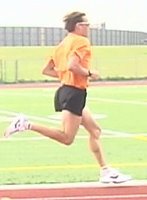More on Footstrike in Running
Research typically finds that how long your foot is in contact with the ground is closely related to how quickly you run [1,2]. This makes sense since a foot on the ground is essentially an anchor. You aren't going any place until it comes off the ground. The longer it stays fixed to terra firma the slower you will run. A recent Japanese study provides a lesson in this and reveals how to go about running faster without elevating VO2max or lactate threshold simply by shortening ground-contact time [3].
The Japanese researchers videotaped and later studied the footstrikes of 415 runners including elite international and Olympian runners at the 15-km point in a half marathon. Of these runners 74.9% were found to be rearfoort strikers (RFS), 23.7% were midfoot strikers (MFS), and 1.4% were forefoot strikers (FFS). The percentage of MFS was highest in the fastest runners. Time in contact with the ground was, on average, 9% longer in the RFS (200 +/-23.3 milliseconds) compared with the MFS and RFS (183 +/-16msec). The RFS runners had the slowest race times and MFS the fastest.
The Base period is the time to improve your running technique and for most runners the quickest way to become a faster runner before next season is to become more economical by learning to run with a midfoot strike rather than a heel strike. If you want to see what this looks like go to www.trainingbible.com and click on FREE RESOURCES to find a video of a runner who uses the MFS technique. Be aware that forcing a dramatic change in footstrike in a short period of time can result in foot and leg injuries. Allow several weeks for the change by gradually increasing how much time you run with the new technique.
References
1. Paavolainen L, et al. 1999. Explosive strength training improves 5-km running time by improving running economy and muscle power. Journal of Applied Physiology 86(5):1527-1533.
2. Paavolainen L, et al. 1999. Neuromuscular characteristics and fatigue during 10-km running. International Journal of Sports Medicine 20(8):516-521.
3. Hasegawa H, et al. 2007. Footstrike patterns of runners at the 15-km point during an elite-level half marathon. Journal of Strength and Conditioning Research (21(3):888-893.
Labels: footstrike, running



5 Comments:
It's interesting watching the video - the running just looks so right!
Do you have any tips on how to know which type of runner you are (RFS / MFS / FFS), and how to adapt your technique from either RFS or FFS to become MFS?
Karl-The first step in modifying your run technique to MFS is becoming aware of what you currently do. As in the study cited here, video is excellent for this. Watch the video in slow motion and note how your foot comes in contact with the ground. When I first start coaching someone who is a RFS, after doing the video, they start with 2 sessions in a week of 'strides' workouts on grass or other soft surface. Very slight downhill is best. This can be a part of the warm-up for a run. Run 20 sec/100m faster than 5k pace focusing on good MFS. Walk/skip/hop back to start point emphasizing awareness of foot position. Repeat. Barefoot, if possible, or at least with a minimalist shoe (check the grass for broken glass etc). They'll do 5-8 of these strides in a workout with a couple of days between the workouts. When ready they go to 3-4 such workouts in a week. In a few weeks they are incorporating the technique into portions of every run. Some adapt quickly with no leg issues. Others take longer and flirt with leg soreness for a few weeks. That's why the best time to make such a change is the Prep and early Base periods. To learn a new technique in any sport, it's best to do short sessions frequently rather than long sessions infrequently.
Running is much more enjoyable for me since I started grokking the whole high cadence/mid-foot strike thing. It's like changing from a masher to a spinner in cycling.
I'm pretty certain that the Pose and Chi schools of running are aiming toward the same idea, but just use different vocabulary.
-Steve
Hi Joe -
Thanks for this very comprehensive answer! I live right next to the beach, so barefoot strides on the sand looks like how I'll tackle this - having first had a careful look at some video footage of my own running style.
Hi Joe,
This post is quite interesting. As I have been running for a few years now, and started with a rear foot strike run. After I had been Running for a while (and getting injured quite often while doing it) some one pointed me in the direct of a book called 'Chi Running' by Danny Dreyer. In this book, he discribes the optimal foot stike as MFS, in combination with other techniques for running, that will improve your running, and reduce / eliminate injury. After reading this, and Practicing Chi running, I have not had to stop running because of injury. Also, he points out that rear foot strike, or Heal foot strike, causes shin splints, and undue stress on your shins! so apart from improving speed (in the long term) in short term, it should reduce injury!
Post a Comment
<< Home